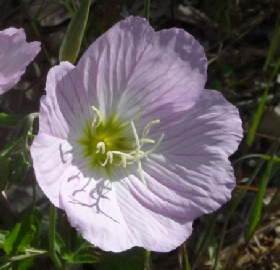Oddly not listed in the Epple book. My identification is based on the leaves, their oval-
I used to see these, especially the larger white one that is also down our alley here, and think of them as surely Morning Glories because (despite the Wikipedia description to the left) I always find them wide open in the morning. A quick way to know you’ve got an Evening Primrose is to turn the flower down to find the hanging, often turned-
Pink Evening Primrose. (Pink Ladies, White Evening Primrose.)
Oenothera speciosa.
Onagraceae.. Evening Primrose Family.
SEINet link to this flower. Late May, N roadside, my house. Neighbor has a nice bunch of these at their curbside.
This is a panel. Close it by clicking somewhere not on it. May take two clicks.
May include gaphics and hyperlinks.

Credit: Wikipedia for the plant description. Family description: Plants of Arizona, Anne Orth Epple updated by John F Wiens. Photos by Lewis E. Epple. A Falcon. Guide. 2nd ed 2012. My photos.
The pink primrose has glabrous (smooth) to pubescent stems that grow to 50 cm in height. The pubescent leaves are alternate with very short or no petiole (sessile), reaching 10 cm long to 4 cm broad. They are variable in shape, from linear to obovate, and are toothed or wavy-

